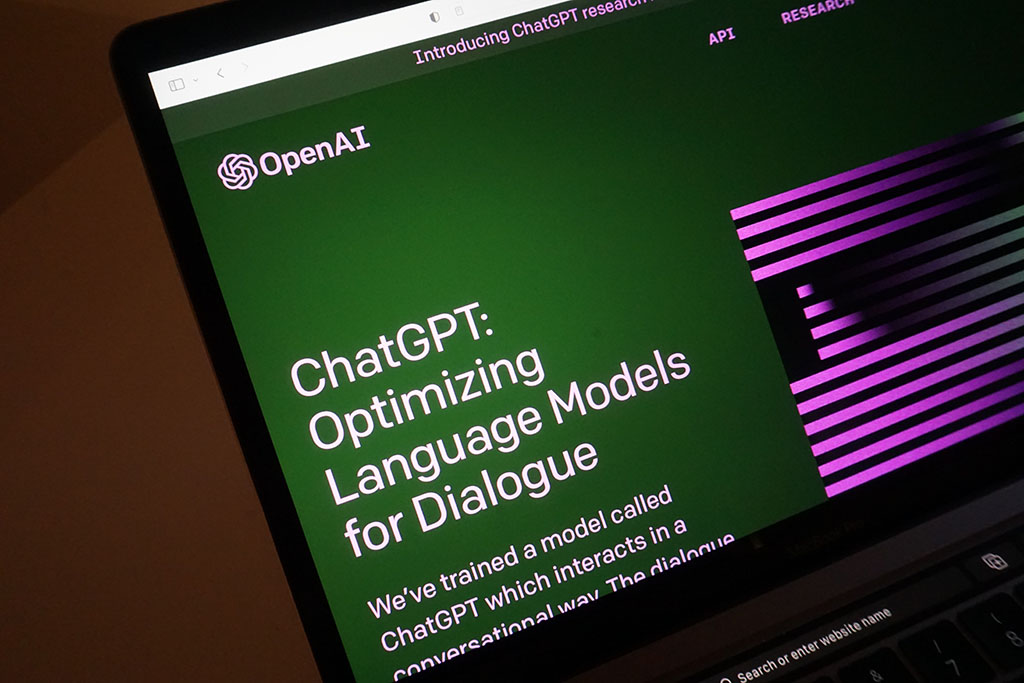“ChatGPT is a powerful language model that has the potential to revolutionize the way we interact with and utilize artificial intelligence in our daily lives. Its ability to generate human-like text allows it to assist with a wide range of tasks that involve language processing, making it a valuable tool for businesses, researchers, and individuals alike.”
– Said ChatGPT when asked to make a quote about itself.
– https://www.supplychaintoday.com/best-chatgpt-quotes/
An Overview of ChatGPT Uses
“ChatGPT is incredibly limited but good enough at some things to create a misleading impression of greatness. it’s a mistake to be relying on it for anything important right now. it’s a preview of progress; we have lots of work to do on robustness and truthfulness.”
– Sam Altman, CEO of OpenAI
– Twitter 12/10/22.
ChatGPT is an AI-powered chatbot that can generate human-like text based on user input. It is based on a large language model that can learn from a massive amount of data and produce coherent and relevant responses.
ChatGPT is a powerful tool that can be used for various purposes, such as entertainment, education, research, or business. In this blog post, we will explore some of the cool things that you can do with ChatGPT and how to get the best results.
Play Games
One of the fun things that you can do with ChatGPT is to play games with it. ChatGPT can act as a game master, a player, or a commentator, depending on the type of game and the user’s preference. For example, you can play trivia games with ChatGPT, which can ask you trivia questions on a wide range of topics, such as history, science, sports, or pop culture. You can also challenge ChatGPT to answer your trivia questions and see how well it knows the subject matter. ChatGPT can also play role-playing games with you, where it can create a fictional character and a storyline based on your input. You can interact with ChatGPT’s character and influence the outcome of the game. ChatGPT can also comment on your gameplay and give you feedback, tips, or jokes.
Learn New Things
Interact with ChatGPT to learn new things. ChatGPT can act as a tutor, a mentor, or a coach, depending on the topic and the user’s goal. For example, you can learn a new language with ChatGPT, which can teach you vocabulary, grammar, pronunciation, or culture. You can also practice your language skills with ChatGPT by having a conversation with it in different languages. ChatGPT can also help you with complex topics, such as math, physics, or computer science. You can ask ChatGPT to explain concepts, solve problems, or give examples. ChatGPT can also help you with creative writing, where it can give you prompts, suggestions, or feedback. You can also collaborate with ChatGPT to write stories, poems, or songs.
Create Content
Another cool thing that you can do with ChatGPT is to create content with it. ChatGPT can act as a content creator, a content editor, or a content generator, depending on the type of content and the user’s need. For example, you can create a cover letter with ChatGPT, which can help you write a professional and persuasive letter based on your resume and the job description. You can also edit your cover letter with ChatGPT by asking it to check your spelling, grammar, or tone. ChatGPT can also generate content for you, such as product descriptions, email templates, or blog posts. You can give ChatGPT a topic, a keyword, or a starting point, and it will produce relevant and engaging text for you.
Have Fun
Use ChatGPT prompts to have fun. ChatGPT can act as a friend, a comedian, or a celebrity, depending on the user’s mood and interest. For example, you can chat with ChatGPT about anything you want, such as your hobbies, your dreams, or your problems. ChatGPT can listen to you, empathize with you, or give you advice. You can also joke with ChatGPT, where it can tell you funny stories, puns, or riddles. You can also laugh at ChatGPT’s jokes or challenge it to make you laugh. ChatGPT can also impersonate a celebrity, such as Elon Musk, where it can talk to you as if it were him. You can ask ChatGPT about his life, his projects, or his opinions.
“In the symphony of AI, let GPT be the rhythm, but always let human ethics be the lead.”
– Enamul Haque, The Ultimate Modern Guide to Artificial Intelligence: Including Machine Learning, Deep Learning, IoT, Data Science, Robotics, The Future of Jobs, Required Upskilling and Intelligent Industries
– https://www.goodreads.com/work/quotes/86795733
Specific ChatGPT Ideas
ChatGPT’s capabilities extend beyond typical text-based interactions, and there are several cool, unique, and interesting things it can do that might surprise the average person. Here are some lesser-known applications:
- Code Writing and Assistance – ChatGPT can assist with coding tasks by generating code snippets, helping users troubleshoot issues, or providing explanations of programming concepts. Ask for an explanation of how the Python language uses object-oriented programming concepts.
- Creating and Solving Puzzles – You can use ChatGPT to generate creative puzzles or riddles and even to solve puzzles by providing relevant details. Ask ChatGPT: “If a train leaving Boston at 11 am and traveling East at 25 miles per hour. And a submarine is traveling West at 22 knots . . . “
- Learning New Topics – Ask ChatGPT to provide explanations or summaries on a wide range of topics, making it a handy tool for quick learning and research. Ask for an explanation of how a toaster or a refrigerator works.
- Song Lyric Generation – Request ChatGPT to generate song lyrics in a specific style or on a particular theme, sparking creativity for musicians and songwriters. Ask for song lyrics about a quiet day fishing in the style of Rammstein.
- Drafting Poetry – If you’re feeling poetic, use ChatGPT to assist in crafting verses or generating lines of poetry, exploring different styles and themes. Ask for a poem about butterflies in the style of Edgar Allan Poe.
- Text-Based Games – ChatGPT can be used to create text-based adventure games or interactive stories, responding dynamically to user input. Ask to generate and play Asoka with Baylan Skoll.
- Simulating Characters for Roleplaying Games – Generate dialogues and responses for characters in tabletop or online roleplaying games, adding depth to the narrative. Ask ChatGPT to generate a backstory for your character.
- AI Dungeon Master – With its conversational abilities, ChatGPT can take on the role of a dungeon master in a tabletop RPG, guiding players through a dynamic and interactive story.
- Inventing Recipes – Request ChatGPT to come up with unique recipes, combining ingredients and suggesting cooking instructions for an interesting culinary experience. What would Wednesday Adams bake? (Are they made from real Girl Scouts? – https://www.youtube.com/watch?v=2kyu1Mikj1w)
- Storytelling Collaboration – Collaborate with ChatGPT to co-write a story, taking turns and building on each other’s contributions, creating a truly unique and unpredictable narrative.
- Ideation for Creative Projects – Use ChatGPT to brainstorm ideas for art projects, design concepts, or any creative endeavor. Allow ChatGPT to provide a fresh perspective and inspiration. The 1928 ‘Steamboat Willie’ version of Mickey Mouse enters the public domain on January 1, 2024. (https://web.law.duke.edu/cspd/mickey/) What new properties can be generated with ChatGPT and the mouse?
- Generating Jokes and Humor – Ask ChatGPT for jokes or amusing anecdotes, turning it into a virtual stand-up comedian for moments of levity. “What do you get when you cross Winnie the Pooh and a skunk? Winnie the Pew.” Your mileage may vary. 😉
ChatGPT Uses – Lightning Round
- Return results like a search engine
- Write a new CV or resume
- Improve an existing CV or resume
- Prepare you for a job interview
- Write original jokes
- Compose music
- Summarize and simplify complex topics
- Return a concise history of a given era
- Convert text from one format to another
- Solve math problems
- Answer questions about personal issues
- Offer answers about the meaning of life
- Write, explain, and debug computer programs
- Check computer code for security flaws
- Translate between human languages
- Draft essays and other long-form content
- Respond as a Linux terminal session
- Play 20 questions with you
- Quiz you on a selected topic
- Generate multiple-choice questions on a specific topic to help you study
Remember that while ChatGPT can handle a wide array of tasks, it’s not infallible, and results can vary based on the input and the nature of the request. Experimenting with different prompts and exploring its capabilities can lead to discovering new and unexpected uses.
How to Use ChatGPT
To use ChatGPT, visit https://chat.openai.com and sign up for a free account.
You can then start a conversation with ChatGPT by typing or speaking your input. ChatGPT will respond to you in a human-like way, based on the context and the past conversations. You can also use images, voice, or text-to-image generators to enhance your chat experience.
Visit Gipeties to solve the problem of GPTS overload at https://gipeties.com/ There you can choose from hundreds of GPTs (Gipeties) that are customized for a single purpose, such as Creative Writing, Marathon Training, Trip Planning, or Math Tutoring. You can also create your own GPT by giving it simple instructions.
Prompting ChatGPT
Here are some tips and best prompt creation practices to get the best results from ChatGPT:
– Be specific and clear. ChatGPT works best when you give it a clear and specific input. Avoid vague or ambiguous inputs that may confuse ChatGPT or lead to irrelevant or nonsensical responses. For example, instead of asking “What is the best way to learn a new language?”, you can ask “List 7 effective methods for learning South American Spanish?”.
– Be creative and curious. ChatGPT is a creative and curious chatbot that can generate amazing things and learn new things. Therefore, you should be creative and curious when you chat with ChatGPT and explore its capabilities and limitations. You can try different inputs, follow-up prompts, or topics and see how ChatGPT responds. You can also give ChatGPT feedback, suggestions, or challenges and see how it improves.
ChatGPT is a great tool that can help you with a wide range of tasks and subjects. You can use ChatGPT to play games, learn new things, create content, or have fun. You can also use ChatGPT to discover new things, generate new ideas, or overcome creative blocks. ChatGPT is a fun way to interact with artificial intelligence and machine learning in the digital world. Try ChatGPT today and see what it can do for you.
The RICCE framework for ChatGPT Prompting
The RICCE framework is a structured approach used in AI prompting, particularly in the context of natural language processing models. Each component of the framework—Role, Instructions, Context (Audience), Constraints, and Examples—plays a crucial role in guiding the behavior and output of the AI model. Here’s an overview of each element:
1. Role
- Definition – Describes the specific role or persona that the user wants the AI model to adopt when generating responses.
- Purpose – Helps set the context for the AI, influencing the tone, style, and perspective of the generated content.
- Example – “Acting as an expert in music history,”
2. Instructions
- Definition – Provides clear directives and guidelines for the AI on how to approach the task or generate responses.
- Purpose – Offers explicit guidance to ensure that the AI understands the user’s expectations and requirements.
- Example – “Generate a blog post covering the Ska music style.”
3. Context (Audience)
- Definition – Specifies the intended audience or context for the generated content, including any relevant background information.
- Purpose – Helps the AI tailor responses to a specific audience, making the generated content more relevant and appropriate.
- Example – “Write at a high school level.”
4. Constraints
- Definition – Outlines any limitations, restrictions, or criteria that the AI should consider during content generation.
- Purpose – Prevents the AI from producing outputs that violate certain rules, ensuring alignment with ethical, legal, or specific criteria.
- Example – “Write in a friendly manner. Focus on the impact of the walking bass line.”
5. Examples:
- Definition – Provides concrete examples or templates that illustrate the desired output or behavior from the AI.
- Purpose – Offers reference points for the AI, helping it understand the user’s expectations by showcasing sample responses.
- Example – “Include, in table format, the Ska musicians who influenced Ska most.”
By incorporating these elements into the prompt, the RICCE framework aims to enhance the specificity and clarity of instructions given to AI models. This, in turn, helps users achieve more accurate and contextually appropriate results from the AI, especially in natural language understanding and generation tasks. The framework contributes to better communication between users and AI systems, facilitating the desired outcomes in content-generation scenarios.
Cool ChatGPT Things Resources
- What is ChatGPT
- 8 Surprising Things You Can Do With ChatGPT by Jason Fitzpatrick
- 12 Cool Things You Can Do with ChatGPT by Akshay Gangwar
- 15 Creative Ways to Use ChatGPT by OpenAI By Garling Wu
- 16 Things You Can Do With ChatGPT By Maxwell Timothy
- 20 Fun Things To Do With Chatgpt
- 25 Things You Can Do With ChatGPT by Ravi Teja KNTS
- – [x] ChatGPT: 30 incredible ways to use the AI-powered chatbot by Christopher McFadden
- Gipeties – Solving the problem of GPTS overload
- OpenAI’s new ChatGPT bot: 10 coolest things you can do with it By Ax Sharma
- What can ChatGPT do? Here’s 11 fun and useful ways it can boost your life by Muskaan Saxena
ChatGPT Prompts Resources
- The Free AI Prompt Generator
- 25 Amazing AI Prompt Examples Everyone Can Use!
- AI Prompts 101: Understanding How They’re Created & Used by Kindra Cooper
- Effective Prompts for AI: The Essentials
- Getting started with prompts for text-based Generative AI tools
- How to Write AI Art Prompts Effectively with Examples by Aminu Abdullahi
- How to write effective AI art prompts by Miguel Rebelo
- I Discovered The Perfect ChatGPT Prompt Formula by Skill Leap AI
- Introducing the F.I.T.S. Framework (Prompt Engineering Basics) by The Nerdy Novelist
- Master the Perfect ChatGPT Prompt Formula (in just 8 minutes)! by Jeff Su
More Like This:


